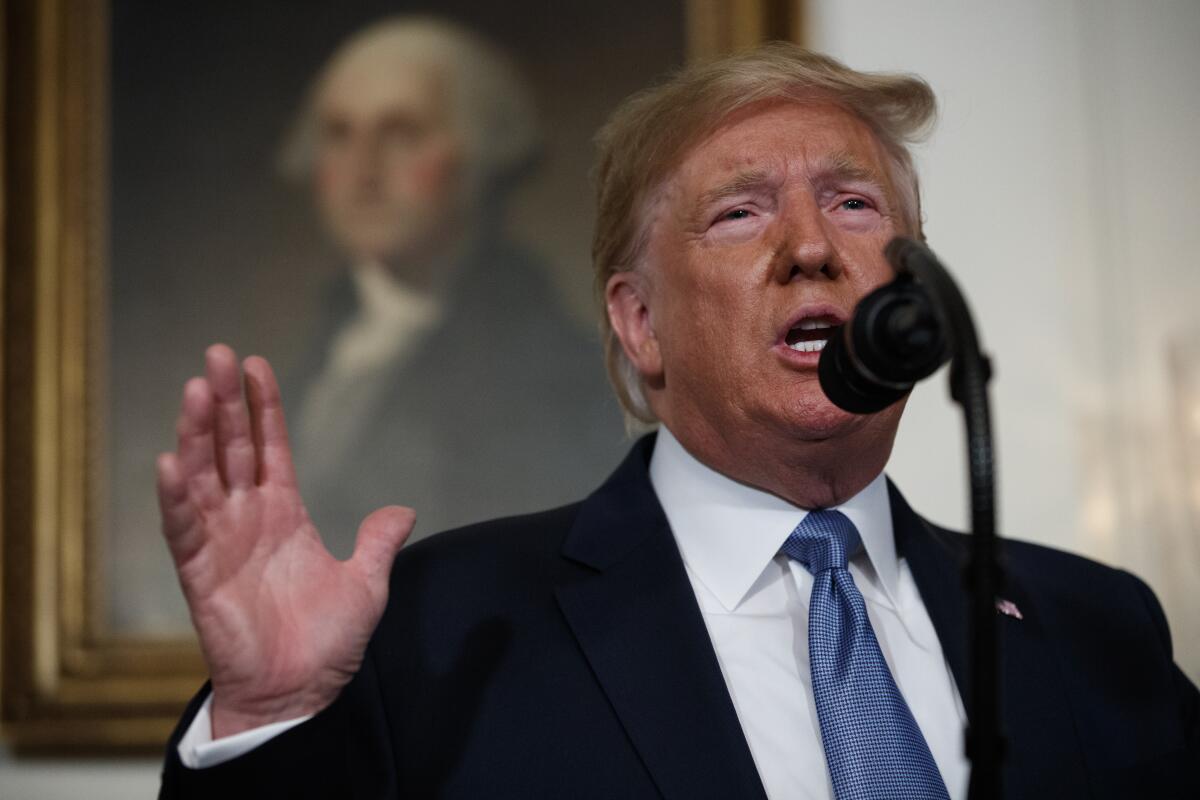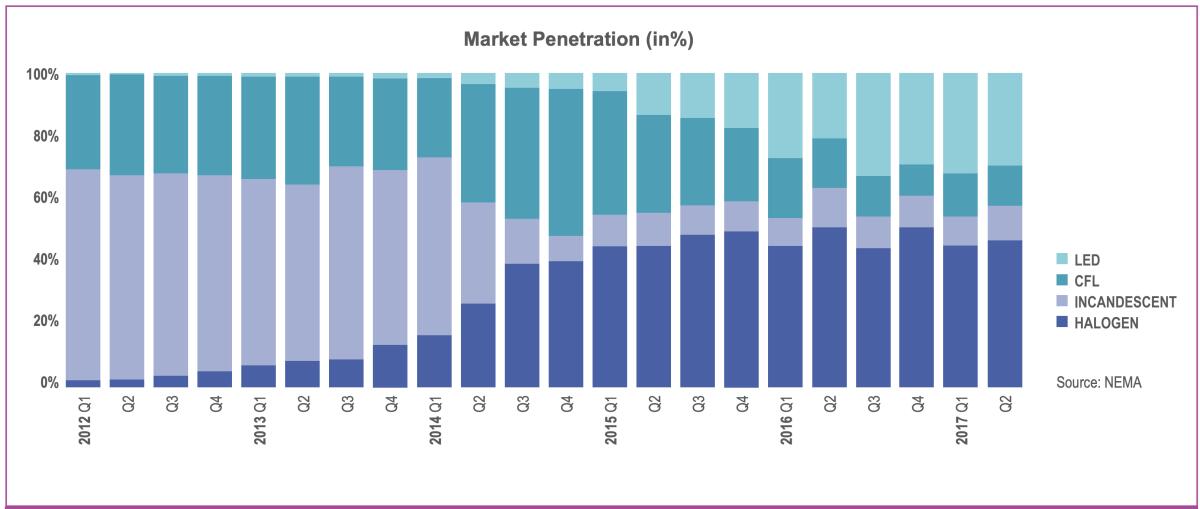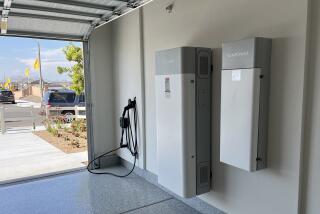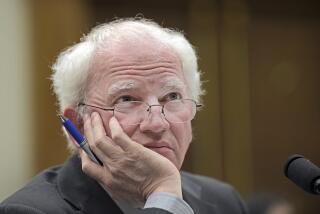Column: Trump’s attack on lightbulb standards is his most inane environmental rollback yet

Consider the lightbulb.
One of the lowliest electric devices in our homes and offices, the lightbulb revolutionized daily life after it was improved through Thomas Edison’s innovations. It became so ubiquitous as to be barely noticeable, except when it burned out and had to be replaced.
Or when rules requiring bulbs to be more energy-efficient became the subject of attacks launched by tea party adherents starting in 2011.
This is about more than just energy consumption, it is about personal freedom.
— Then-Rep. Joe Barton, R-Tex., legislating against light bulb rules in 2011
Surely one of the more witless political causes of our time, the attack on lightbulb standards sure enough got taken up by President Trump, who in September proposed rolling back the efficiency mandate.
Among his complaints was that higher-efficiency bulbs made him “look orange,” that they were more expensive than traditional incandescent lights and that when they break, “it’s considered a hazardous waste site. It’s gases inside.”
On Nov. 4, the counterstroke came from California Atty. Gen. Xavier Becerra, joined by his New York counterpart Letitia James and 13 other states, the District of Columbia and New York City.
They’ve sued to block Trump’s action, which Becerra says not only would be illegal under federal law but also would “undermine state and local energy policy, and increase consumer and environmental costs.”
President Trump’s petty, absurd war with California plumbs new lows as he tries to invalidate the state’s cap-and-trade anti-pollution agreement with Quebec.
Becerra didn’t mention one other point of interest for California: The inventor of the most common efficient lightbulb technology used today is one of us. He’s Shuji Nakamura, a tenured professor at UC Santa Barbara, who won the Nobel Prize in 2014 for his work on high-efficiency blue light-emitting diodes, the crucial components of today’s LED lightbulbs.
In September, UC sued Amazon.com, Target, Walmart, Bed, Bath & Beyond and Ikea at the International Trade Commission for importing LED bulbs that allegedly infringe on patents held by Nakamura and two other UCSB professors. A companion suit was filed in federal court. Both actions are pending.
That brings us up to date on the latest formalities swirling around lightbulbs. Now let’s look at the background.
The phase-out of ordinary incandescent bulbs — those Edison-style bulbs with tungsten filaments — began with the Energy Independence and Security Act signed by President George W. Bush in 2007. The measure didn’t ban all incandescent bulbs, but required that they move toward 25% reductions in energy use over time. Specialty products such as three-way, chandelier and refrigerator bulbs were exempted.
Traditional bulbs had obvious inefficiencies, since 90% of the energy they used was dissipated as heat rather than light. They also burned out after months or even weeks of heavy use, producing waste.

The most common alternative, compact fluorescent bulbs, or CFLs, were more expensive at the store, but more efficient, cooler and longer-lasting, so they saved consumers money in the long term. (These are the bulbs that look like small fluorescent tubes crammed into a spiral shape.)
CFL sales soared, but they also had their downsides — they emitted a harsher light and also contained mercury, which made their disposal challenging.
The risk was modest in normal use, but environmental experts nevertheless recommended alarming precautions if one broke in the house: “Remove children and pets from the room, and then clean up the broken bulb as quickly as possible,” advised the Environmental Defense Fund. “Increase the ventilation in the room where the bulb broke by opening windows and doors. ... To be extra safe, stay out of the area for a few hours to let any remaining mercury disperse.”
So Trump wasn’t exactly wrong when he talked about “hazardous waste.” But he was behind the times. CFLs began to give way to less environmentally damaging LED bulbs in 2014 and were trailing them in sales by the beginning of 2016. CFLs are now almost entirely on the way out.
LEDs, meanwhile, have improved to the point that you can buy them in virtually any decorative style and intensities ranging from the hard white light of a security spot to the soft glow from under a living room lampshade. As for efficiency, they convert as much as 90% of their electricity into light.
Trump’s authority to revoke California’s waiver from federal clean air rules rests on a very shaky legal foundation.
Along the way, however, lightbulb regulations have become a right-wing cause, in part because the Obama administration had expanded and tightened the rules on incandescent bulbs.
In the Republican response to President Obama’s 2011 State of the Union address, then-Rep. Michele Bachmann (R-Minn.) railed against “a bureaucracy that now tells us which lightbulbs to buy.”
Then-Rep. Joe Barton (R-Texas) a member of the tea party caucus, introduced a bill in 2011 to roll back the regulations. “This is about more than just energy consumption, it is about personal freedom,” he said. “People don’t want Congress dictating what light fixtures they can use.”
In a speech during the 2012 presidential campaign, Mitt Romney jibed, “the government would have banned Thomas Edison’s lightbulb. Oh, by the way, they just did, didn’t they?” (Romney blamed Obama’s regulators, but of course it was George W. Bush’s signature that set the rules in motion.)
The truth is that the lightbulb rules make sense on a macro as well as a household scale. Reducing power consumption in the home by replacing incandescent bulbs with LEDs consuming as little as 10% of the power for similar lighting would save the equivalent of the output of 25 to 30 large power plants of 500 megawatts each, the Congressional Research Service calculated.
The Department of Energy estimated that the average 60-watt incandescent bulb cost a family $4.80 in electricity over a year based on two hours a day of use and would last 1,000 hours, the equivalent of about a month and a half of 24-hour use.
GM, Fiat Chrysler and Toyota, which are siding with Trump in his battle over California emissions rules, are among the worst performing carmakers on emissions.
An LED bulb emitting the same light would cost $1 a year and last 25,000 hours, the equivalent of nearly three years of constant use. LEDs also have come way down in price, and can be found at retail stores for as little as $2 to $3 each. That makes them competitive with incandescent bulbs, which run to about $1 each — if you can even find them today on store shelves.
Notwithstanding the tea party persiflage about freedom of choice at the lightbulb counter, it’s probably more appropriate to see the issue as part and parcel of conservatives’ broader war on energy efficiency policies.
In July, for instance, Ohio’s Republican Gov. Mike DeWine signed a bill that would bail out four uneconomical nuclear and coal plants while hacking away at his state’s once-pioneering renewable energy standards and ending them outright in 2026. The bill was passed at the behest of entrenched nuclear and coal plant operators.
The Trump administration has mounted its own war on energy efficiency. As we’ve reported, the tactics include rolling back automobile emission and fuel efficiency standards on which California has been a leader, attempting to invalidate the state’s cap-and-trade program limiting greenhouse gases, and moving to weaken Obama-era clean power standards governing coal plants. As Trump said on Sept. 13 at a House Republican retreat in Baltimore, “we ended the last administration’s heartless war on American energy.”
The faith of coal advocates in the doctrine of “clean coal”— technology that would allow utilities to burn coal for electricity without somehow poisoning the environment — has suffered a possibly fatal blow.
Yet Trump’s effort to turn back the clock on energy — promoting oil, gas and coal and aching for the halcyon days of incandescent lighting, can’t work in the real world. The coal industry is terminal; on Oct. 29 the giant Murray Energy filed for bankruptcy, the third coal company to go bust this year alone.
What Trump’s case against the lightbulb rules shares with his other retrograde energy policies is the absence of any recognition that the rules’ gains in economics and public welfare and health outweigh their upfront costs, much less their constraints on individual “freedom.”
It’s not as if the administration doesn’t know about those gains. As California and the other states observed in their lawsuit, the Department of Energy’s own analysis projects that the lightbulb rules will generate a cumulative savings for consumers of more than $2 trillion in utility bills through 2030 and reduce emissions of carbon dioxide, a greenhouse gas that promotes climate change, by 700 million metric tons.
That’s equivalent to “taking nearly 150 million cars off the road for a year, or more than enough to meet the electricity needs of every American household for one year,” the states noted.
In light of those estimates, what are the arguments in favor of rolling back the rules? There are none. The lightbulb industry itself has moved on, as one can see by the scarcity of incandescent bulbs in the retail chain. The inconvenience of moving to LED bulbs is minimal, especially given the longer-term savings.
Trump had no rationale other than riling up a constituency dubious of any government intervention. Thanks are due to California and its fellow states for shining a spotlight on yet another half-baked rule-making adventure at the White House.









